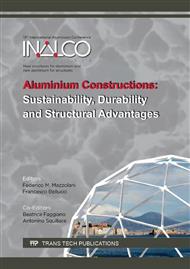p.390
p.396
p.402
p.409
p.415
p.421
p.427
p.433
p.439
Direct Methods of Plasticity in Aluminium Frames Accounting for Eurocode 9 Failure Criteria
Abstract:
Metal structures, given their broad plastic deformation capacity, have been often at the core of research for the evaluation of the post elastic behavior via the direct methods of plasticity. Limit and shakedown analysis were often exploited to determine the plastic collapse load capacity, as they provide advantages in terms of computational robustness in comparison with incremental non-linear analysis. The aforementioned approach has been widely and effectively applied for steel structures, characterized by rigid-plastic behavior. Υet in the case of aluminium structures, there are special parameters to be considered, as they exhibit a relationship of round-house type, whose trend cannot be interpreted through the classic elastic-perfectly plastic material law idealization.The present paper aims to develop a limit and shakedown analysis formulation suitable for the safety assessment of 3D aluminium frame structures against plastic collapse. Research yielded the proposed two-surface methodology in the framework of stress resultant plasticity, which is capable of estimating the plastic collapse limit state of real-life aluminium frames, incorporating Eurocode 9 codified failure criteria and limited kinematic hardening. A numerical example of a 3D frame is realized utilizing the finite element method and the 3-node Timoshenko column-beam element, in order to showcase the proposed methodology and validate the influence of hardening effect.
Info:
Periodical:
Pages:
415-420
Citation:
Online since:
September 2016
Price:
Сopyright:
© 2016 Trans Tech Publications Ltd. All Rights Reserved
Share:
Citation:


